You have a whole house water filter for your home, and your water has been nice and clear because of it. But your not quite sure when you should be changing the filter cartridge. You have changed it once in a while but are you changing your whole house filter cartridge enough?
How often you need to change your whole house filter will depend on water usage, what type of filter cartridge that you are using, and what you are filtering. Generally, you should change your filter often enough to prevent pressure loss or before particles are no longer being filtered.
How often a whole house filter needs to be changed will depend on several factors. There is no one answer when it comes to how often you should change your water filter, but the more that you know about your whole house filter will help you know how often to change it.
What are you filtering from your water?
Sediment:
Small amounts of tiny sediment particles may accumulate very slowly on a water filter which means that it would not need to be changed as often as if there where a high amount of larger-sized sediment particles.
Using a pleated polyester filter cartridge will provide more filtering surface area and therefore a pleated polyester filter cartridge will generally need changing less often than a solid block filter when filtering out light sediment.
Of course, the amount of sediment in the water, the size of the sediment particles, and the volume of water used will have a bearing on how often a sediment filter cartridge will need to be changed.
Potential months of life expectancy of a 5-micron spun polypropylene sediment filter cartridge. *
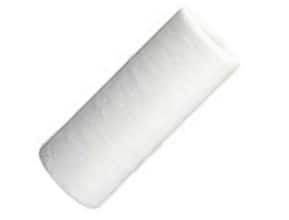
| With a 5 micron spun polypropylene filter cartridge | Filter cartridge size | 1 Adult | 2 Adults | 3 Adults | 4 Adults | 5+ Adults |
| Light Sediment | 2.5″x10″ | 12 | 8 | 6 | 3 | 1 |
| Light Sediment | 2.5″x20″ | 24 | 18 | 15 | 10 | 6 |
| Light Sediment | 4.5″x10″ | 20 | 16 | 12 | 9 | 6 |
| Light Sediment | 4.5″x20″ | 30 | 24 | 18 | 15 | 12 |
| Moderate Sediment | 2.5″x10″ | 9 | 7 | 3 | 1 | 1 or less |
| Moderate Sediment | 2.5″x20″ | 15 | 12 | 9 | 6 | 3 |
| Moderate Sediment | 4.5″x10″ | 12 | 9 | 6 | 3 | 1 |
| Moderate Sediment | 4.5″x20″ | 18 | 12 | 9 | 6 | 3 |
| Heavy Sediment | 2.5″x10″ | 3 | 2 | 1 | 1 or less | Less than 1 |
| Heavy Sediment | 2.5″x20″ | 9 | 7 | 5 | 3 | 1 |
| Heavy Sediment | 4.5″x10″ | 7 | 5 | 3 | 2 | 1 |
| Heavy Sediment | 4.5″x20″ | 12 | 9 | 6 | 3 | 2 |
Potential months of life expectancy of a 30-micron pleated polyester sediment filter cartridge. *
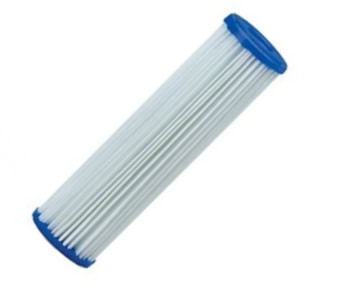
| With a 30 micron pleated polyester filter cartridge | Filter cartridge size | 1 Adult | 2 Adults | 3 Adults | 4 Adults | 5+ Adults |
| Light Sediment | 2.5″x10″ | 18 | 12 | 9 | 6 | 3 |
| Light Sediment | 2.5″x20″ | 36 | 24 | 18 | 12 | 6 |
| Light Sediment | 4.5″x10″ | 30 | 20 | 15 | 10 | 3 |
| Light Sediment | 4.5″x20″ | 36 | 28 | 24 | 15 | 10 |
| Moderate Sediment | 2.5″x10″ | 12 | 9 | 6 | 3 | 1 |
| Moderate Sediment | 2.5″x20″ | 24 | 18 | 12 | 6 | 3 |
| Moderate Sediment | 4.5″x10″ | 18 | 15 | 12 | 9 | 5 |
| Moderate Sediment | 4.5″x20″ | 30 | 24 | 18 | 12 | 9 |
| Heavy Sediment | 2.5″x10″ | 9 | 6 | 2 | 1 | 1 or less |
| Heavy Sediment | 2.5″x20″ | 18 | 15 | 10 | 3 | 2 |
| Heavy Sediment | 4.5″x10″ | 15 | 12 | 9 | 6 | 3 |
| Heavy Sediment | 4.5″x20″ | 24 | 18 | 12 | 9 | 6 |
* Every home is different. Water usage and changing water supply may require changing a filter cartridge more or less often than estimated.
Non-dissolved iron:
If you are filtering out non-dissolved iron (Ferric Iron)from your water, the filter may become discolored very quickly, but it could take a long time before enough non-dissolved iron builds-up on the filter to the point where the filter cartridge needs to be changed.
Dissolved Iron:
Approximating the life expectancy of a filter cartridge is very difficult when it comes to dissolved iron (Ferrous Iron)in water because the amount of iron can easily change due to changes in rainfall and the volume of water being used.
As each home will have a different level of dissolved iron in the water, you will have to judge for yourself exactly how often you will have to change your filter cartridge but here is a basic guideline.
Potential months of life expectancy of a 5-micron spun polypropylene 2.5×10 inch filter cartridge for dissolved iron. A 2.5×20 inch sediment filter cartridge may last about twice as long.*
| With 5 micron 2.5″ x 10″ spun polypropylene filter cartridge | 1 Adult | 2 Adults | 3 Adults | 4 Adults | 5+ Adults |
| Light Non-dissolved iron | 12 | 9 | 6 | 3 | 2 |
| Moderate Non-dissolved iron | 9 | 6 | 4 | 2 | 1 |
| Heavy Non-dissolved iron | 7 | 4 | 3 | 2 | 1 or less |
* Every home is different. Water usage and changing water supply may require changing a filter cartridge more or less often than estimated.
Mica:
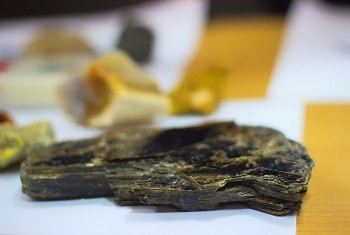
Mica often has a very thin and fine shape which can allow it to work its way through a less dense filter cartridge such as a 20 or higher micron rated filter. In order to capture mica, a finer 5 or less micron filter cartridge may be needed.
Because filtering out mica usually requires a finer filter cartridge, the filter cartridge may need to be changed much more often than a less dense filter cartridge. Also, when using a finer filter cartridge, you may capture other particles which may also cause the filter cartridge to require more frequent changing.
Chlorine:
Municipal water suppliers will usually treat the water with chlorine to disinfect it and make it safe for consumption. The problem is that they usually don’t take the Chlorine back out of the water.
This means that the homeowner may need to use an Activated Carbon Filter Cartridge to remove the chlorine from the water.
Depending on how close your home is to the point where the water is treated with Chlorine, you may need to change your Activated Carbon Filter very often or perhaps just occasionally.
The farther away your home is from the point where the chlorine was added to the water, the lower the level of chlorine that you may need to remove because the chlorine has been diluted by the water and has become weaker.
Most of the time, I recommend using a large 4.5-inch x 10 inch activated carbon filter cartridge to be used in a large water filter housing so it does not need to be changed as often as a smaller, standard-sized activated carbon filter.
Water filters come in many different styles for filtering out many different impurities.
Naturally, a larger water filter cartridge will need to be changed less than a smaller one. But the larger the filter cartridge, the more it will cost so getting a bigger water filter housing will mean having to purchase more expensive and sometimes harder to find filter cartridges.
I only recommend installing a large whole house filter when there is a high volume of water being used, and using a standard-sized water filter would mean having to change the filter cartridge far too often.
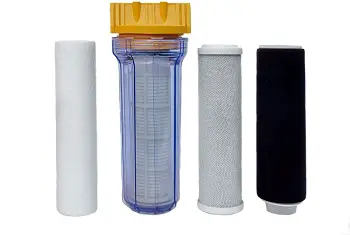
Water filter cartridges come in different micron ratings which are a measurement of the size of particle that the filter cartridge can filter from the water. The lower the micron rating, the smaller the particles that it can filter out.
This may sound like you should simply use a lower micron rated filter for your home to remove the smallest particles possible.
While, if you have a problem with very fine particles in your water this may be true, using a lower micron rated filter cartridge than is needed may mean that you will be changing the filter cartridge considerably more often than if you used a higher micron cartridge that is sufficient for your water filtering needs.
I always recommend that you start by using a 30-micron water filter cartridge and see if it solves your water-sediment issue. If you find that you are still seeing sediment in your water, then you should then try a lower micron rated filter cartridge.
By using the highest micron rated filter cartridge that works for your sediment issue, you will maintain better water pressure in the home and not need to change the filter cartridge more often than needed.
How much needs to be filtered?
Naturally, the more of anything that needs to be filtered out of your water will mean that you will have to change or clean the filter that is removing it from the water more often.
If your water supply contains a high amount of sediment, your sediment cartridge will become full of sediment much quicker than if your water supply just has a small amount of sediment.
This also applies when you need to filter out chemicals like chlorine or particles than create odors or odd tastes in your water.
To remove chlorine or particles that create bad tasting or smelling water, an activated carbon filter will work well, but in time the carbon will no longer be able to remove any more particles because the carbon can not capture any more particles.
An activated carbon filter being used in a home to remove 2 parts per million of chlorine should need to be changed twice as often as the same filter in a home removing only 1 part per million of chlorine if the water volume is the same.
Unfortunately, if you have a water softener, you may not know when your carbon filter is no longer able to remove chlorine from your water. This is because the water softening resin that removes hard minerals from your water will also remove chlorine from your water.
This may sound like a good thing but while water softening resin will remove chlorine from your water, the chlorine will also damage your water softening resin, making it no longer able to soften your water.
Read my article “Does Water Softening Resin Go Bad?” for more about how chlorine can damage your water softening resin.
How much water are you using?
It isn’t just about how much water you are using, but it is also about how much water you are drawing from your well.
If you are using water faster than your well is filling, water may be rushing into your well which can stir-up sediment from the well and the channels flowing into it. The lower the water level in your well, the better the chance that sediment can get stirred-up.
Heavy water usage over a short period of time can lead to high sediment in your water which can lead to having to change your water sediment filter more often.
If this is an issue, staggering your water usage can make a big difference in how often you have to change your filter.
Spacing out showers, laundry, and other high volume water usage throughout the day and making sure that your water softener is operating when no water is being used elsewhere in the home can be an effective way to limit the amount of sediment that gets drawn up from your well.
What type of water filter cartridge are you using?
Many people want to use the lowest micron filter cartridge that they can, thinking that it will provide them with the purest water.
While that may be true, if you don’t have very fine sediment in your water, using a very fine water filter cartridge will just reduce your water pressure which can mean that you will have to change the filter cartridge more often.
I only recommend using a low micron water filter cartridge when you are filtering out non-dissolved iron from your water or if you have a problem with very fine sediment.
Sticking with a higher micron pleated polyester filter cartridge when possible will provide sufficient filtering for most situations and require less frequent changing.
Don’t always go by what the label says!
If you have checked out the labels on water filter cartridges, you have probably seen them say something like “Three Month Cartridge” or “One Year Cartridge”, but no company can accurately judge how long a water filter cartridge will last for your home.
When a filter cartridge label says “Three Month Cartridge”, it is actually just referring to the density and design of the filter cartridge.
The more surface area on a filter cartridge means that there is more area to capture sediment on and the denser that a filter cartridge is, the finer of a particle that it is able to filter out of the water.
So a filter cartridge that says “Six Month Cartridge” is basically just stating that the filter cartridge has more surface area, it is less dense or has more surface area and is less dense than the same brand filter cartridge that says “Three Month Cartridge”.
Because every home is different and has different water filtering needs, a “Three Month Cartridge” may only need to be changed once a year in one home where it may only last a single month in another home with more sediment or higher water usage.
Pleated sediment filters will hold more sediment and last longer.
The whole idea behind a pleated water filter cartridge is that the pleating creates a far larger surface area to capture more sediment than a non-pleated filter cartridge.

If sediment is what you intend to filter and you do not have very fine particles of sediment, a pleated polyester will require changing less often simply because of the larger surface area.
Polyester filter cartridges are generally stronger than cellulose cartridges.
Sediment in water is often smooth around the edges but it can often have rough edges that can cut and penetrate a cellulose “Paper” filter cartridge.
Although a pleated cellulose filter cartridge can filter as well as a polyester one, if there are any coarse or jagged-edged sediment in your water, it may work its way through a cellulose filter and could get into your water softener valve.
Not only is a pleated polyester filter cartridge stronger but it can often be rinsed off and reused several times.
Initially, a pleated polyester filter cartridge may cost a few dollars more than a cellulose cartridge, but if your sediment has any sharp edges, you may be better off using a polyester cartridge and because it is stronger than cellulose, it may not require replacement as often as a cellulose cartridge.
Solid sediment filters will filter out smaller particles but need to be changed more often.
Unlike a pleated filter cartridge, a solid spun polypropylene filter only has the outside surface area to capture larger sediment that may be in your water. Once the outside of the filter cartridge is covered with sediment, the filter needs to be changed or cleaned.

Even though a solid spun polypropylene may need to be changed more often than a pleated filter cartridge they work better at capturing very fine particles that can penetrate deep into the filter.
High water pressure can cause a sediment filter to wear quicker.
Strong water pressure is great, but if you have sediment in your water, that strong water pressure can mean sediment pressing harder on the surface of a water filter cartridge.
As sediment gets captured in a water filter cartridge, it can move around and rub against the filter material. High water pressure can make this rubbing even more effective at causing wear and tear of the filter.
In some cases where a pleated filter cartridge would work well to capture more sediment and therefore require changing less often, a solid filter cartridge may be better at filtering the sediment simply because it will not tear as a pleated filter cartridge could.
A Granular Activated Carbon (GAC) cartridge will generally last longer than a Carbon-Impregnated cartridge.
Although not all Granular Activated Carbon (GAC) filters are created equal, most of them contain more carbon and cleaner carbon than filter cartridges that are only impregnated with carbon flakes.
The carbon grains that are generally inside of a Granular Activated Carbon (GAC) filter cartridge are generally larger with more available surface area to capture impurities.
The more surface area on a grain of carbon means the more pours and crevasses for impurities to get trapped in. And because the carbon is often loose inside of the filter, every part of the grain of carbon has a chance of removing impurities from your water.
For this reason, I recommend using a Granular Activated Carbon (GAC) filter cartridge for most situations where chlorine needs to be removed, there are issues with mild odor in your water or odd-tasting water that can’t be removed using a reverse osmosis system alone.
The size of the filter cartridge can make a big difference in how often you will need to change it.
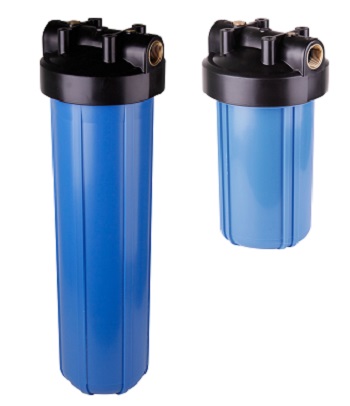
This may sound kind of obvious, but it really needs to be said because many people are only familiar with a standard-sized 10-inch filter housing when in fact, a 20-inch filter cartridge may be a far better choice for homes that use high volumes of water.
A 20-inch whole house filter not only will provide twice the filtering surface for whatever type of filter cartridge that you are using, but it will also allow a high flow of water to provide better water pressure in larger homes.
Always have some extra filter cartridges and Orings on hand, because you never know when your filter may need to be changed.
Nothing can ruin your weekend like noticing that the water pressure in your home has dropped to the point where you can barely take a shower.
You go down to the basement to change your water pre-filter and realize that you don’t have an extra filter cartridge. Oh-no!
While you can often rinse-off the water filter and reuse it for a while, you know that the water pressure will soon drop down again and you will have to go through changing the water filter cartridge again.
Worse yet, you may change the filter cartridge and then find that your water filter is leaking. Hopefully, it will just be that the o ring is worn and you need to put a new one in if you have one available that is.
You know that you will need more filter cartridges and o rings at some point, so why wouldn’t you want to keep a few extra filter cartridges and o rings on hand for when you need them.
Can a water filter cartridge be reused?
You certainly can rinse and re-use a standard sediment filter, but I don’t recommend re-using a sediment filter cartridge that is made from cellulose (paper) because there is a chance that the cellulose surface could tear and allow sediment into your home.
If you would like to be able to re-use a sediment filter, I recommend using a polyester filter because it will be considerably stronger than a cellulose filter cartridge.
You can also re-use a carbon filter cartridge a few times, which can be a great money saver if you use a carbon filter to remove chlorine or odors from your water.
If you notice that the water pressure throughout your home has dropped, it is likely time to change your whole house water filter.
If you are new to your home, you will soon become familiar with the indications that your water filter needs to be changed, and before long, you will be able to change the cartridge in just a few minutes.
Now that you have a better idea about how often you should change your whole house water filter, check out this quick video on how to change it.
If you ever find that your water filter is leaking after you have changed your filter cartridge, check out “How to fix a leaking water filter“.
Not sure what filter cartridge you should be using for your home? See my Recommended Whole House Filter Cartridges.
And if you are looking to install a new whole house water filter, check out my Recommended Whole House Water Filters.

